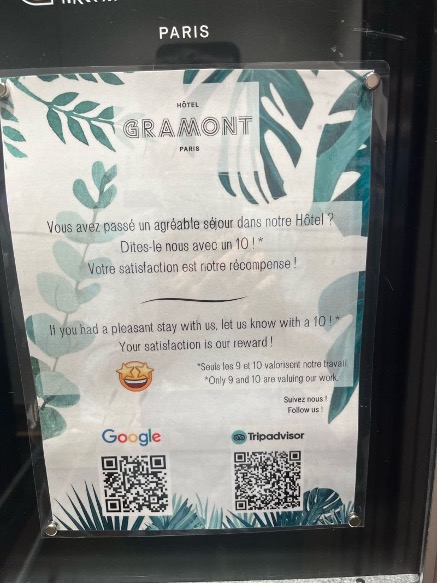We’re surrounded by nudges in our day-to-day lives. Some are so subtle you don’t notice them, while others hit you straight between the eyes and a few border on being unethical.
If you’re unfamiliar with the concept, I’ll keep things simple and define a nudge as a marketing tactic or technique that’s designed to influence someone’s behaviour.
Examples in our everyday lives include:
- Default options on website sign-up pages: For example, auto-selecting the seller’s “preferred” pricing option.
- Product placement: Did you notice the recent reorganisation in many smaller supermarkets where unhealthy items were moved to the back of the store?
- Using labels: Such as “Most Popular Choice” on checkout pages.
And, while I was away in Paris last weekend for the Olympics, I saw this example in our hotel lift. Suggesting that “only 9 and 10 are valuing our work” is hardly subtle and feels more like a hard shove than a nudge.

That got me thinking about how financial advisers, planners, and other business owners can incorporate nudges into their marketing to generate new clients. Here are five practical, simple, and uncontroversial examples.
1. Engage with a prospect’s Twitter/X and LinkedIn posts
You have two choices when it comes to “right-fit” prospects who don’t immediately engage with you:
- Ignore them and move on to the next prospect
- Nurture them, so when they’re ready to engage it’s you they come back to.
The first option means the you waste the time and money you spent creating the prospect, while the second (the correct option, in case you’re in any doubt) improves your conversion rate and means you’ll spend less on marketing.
Engaging with your prospects’ Twitter/X and LinkedIn posts will help to maintain your profile with them and nudge them back to you.
It’s easy too because you can ask Twitter/X and LinkedIn to notify you when a prospect posts. When the notification arrives, head to the post and engage with it, ideally by reacting (for example liking), adding a meaningful comment, or sharing it with your network.
In our experience, very few advisers, planners and business owners connect with their prospects on social media. Even fewer actively engage with their posts to nurture and nudge the prospect back to them.
2. Use the same technique for professional connections
Professional connections, such as accountants and solicitors, are notoriously busy people. So, you have to work hard to establish a meaningful relationship and maintain your profile with them.
And that’s where the social media notification technique we explained above helps.
Connect to all your professional connections on LinkedIn (in our experience fewer are active on Twitter/X) and then click the small bell (screenshot below) so you get a notification every time they post. When they do, engage in the same way we’ve recommended you do with prospects.

3. Use Facebook retargeting to nudge people back to your website
We’ve all been on websites, and then seen adverts for the same site on Facebook.
The technique is called retargeting, and it’s a useful way of nudging people who’ve visited your website back to you.
It’s simple to set up, and one of the only ways to maintain a profile, build brand recognition and nudge people who’ve been on your website back to you, if they haven’t left their details.
4. Send regular updates to professional connections
As I said, forging meaningful and long-lasting relationships with professional connections isn’t easy.
Regular newsletters targeted specifically at accountants and solicitors are a great way to nudge them back to you. So are regular emails (we suggest one every month) updating your professional connections on each client they’ve introduced to you.
Doing this:
- Differentiates you from other advisers/planners because they won’t do it
- Provides the accountant or solicitor with useful information
- Nudges the professional connection back to you.
We’ve talked about this more in a recent blog which you can click here to read.
5. Use these two emails to nudge non-responsive prospects
Even the best salespeople get ghosted from time to time.
When you’ve tried everything else, the best way – by far – that I’ve seen to unstick these prospects is to send either Chris Voss’ “magic email” or Marcus Sheridan’s alternative.
In our experience, the emails work around 80% of the time and the prospect’s reply almost always starts with: “I’m sorry…”.
You’re missing out if you’re not using these emails to nudge prospects back to you.
Click here to learn more about each email, including what they say and when to use them.
Learn more on our next free webinar
The nudge concept is fascinating, and while we’ve given five examples you can use in your sales and marketing here, we’ve only just scratched the surface.
That’s why we’re excited to have Phill Agnew, an expert on the topic, joining us on our next guest webinar. We’ll go live at 10 am on Wednesday 14 August so, if you hurry, you still have time to sign up.
Click here to reserve your place.



